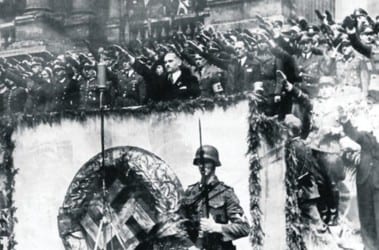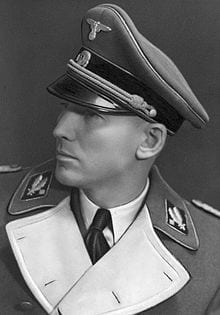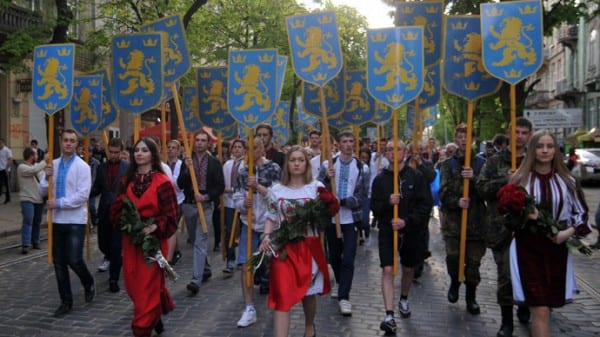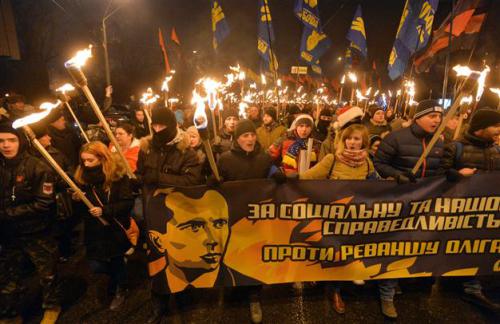Stories from Oles Buzina: SS Galicia Division against Ukraine
Foreword to the Translation
[one_half][dropcap]W[/dropcap]ith the onset of the Ukrainian crisis, I realized that I often looked forward to the work of certain journalists, who were both eloquent and informative. Oles Buzina was one of them. In addition to reading his columns, I, like millions of other Russians, watched his frequent appearances on political talk shows. I often found myself in disagreement, but had to admit that his points were well-argued and factually justified—a true sign of a charismatic erudite.[/one_half]
Thus, the news of his brazen murder on April 16 of this year, in broad daylight and outside his home, was particularly distressing. Later, I found out that Oles—a well-known author and historian, in addition to his journalistic career—had been receiving threats for quite some time. Yet he consistently turned down offers to relocate to Russia. Like a true patriot of a country in peril, he continued to love Ukraine. But Ukraine—today’s Ukraine—did not return that sentiment.
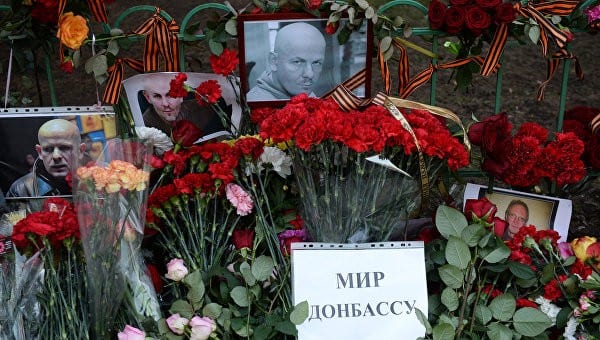
Belated homage to a brave man. Practically unknown in the West thanks to the moral bankruptcy of the Western media.
[dropcap]L[/dropcap]ike clock-work, Western mainstream media called Buzina “pro-Russian” in a political climate where this term has become a slur, in order to reduce the significance of his violent death.
Unlike the recent murder of 1990s politician Boris Nemtsov at the Kremlin walls, no Western embassies solemnly changed their Twitter cover images to his portrait, and no emotional condemnations came from the highest levels of foreign governments within hours of the news. Considering the official West’s backing of the current state of Ukraine, I suppose we should be glad that there was any coverage at all, double standards notwithstanding.
To add insult to injury, since his murder, some bookstores in Kiev even stopped carrying Buzina’s work. At the same time, however, there seems to be greater interest in them online. But posthumous recognition and growing book sales are of little consolation to the women he left behind: his mother, wife, and daughter.
Some of his friends and fellow journalists described Buzina as an “imperial Maloros.” (“Maloros” is a historic term for the residents of central Ukraine within the Russian Empire—ed.) He believed in a cultural and historic unity of Russians, Ukrainians, and Belorussians. And, if this unity were to materialize as it once had, the capital should be in Kiev—which is often called the Mother of Russian Cities—not Moscow.
In particular, it was the Kiev of Mikhail Bulgakov that Buzina loved. And for me, not a single trip home goes without a solitary walk through Bulgakov’s Moscow. We are not so different after all. Indeed, his focus on historic figures like the author of the timeless Master and Margarita—who was, arguably, one of Kiev’s most famous residents—emphasizes his thinking in civilizational categories, rather than those of petty nationalism professed by a vocal minority and the negative identity of today’s official Ukraine, 24 years in the making. And it was this real challenge—one embodied in the following article from 2009—that his ideological approach continued to create for post-Maidan Ukraine that led to his murder, regardless of who was behind it, specifically.
STORIES FROM OLES BUZINA:
THE SS GALICIA DIVISION AGAINST UKRAINE (2009)
(“Stories from Oles Buzina” was a regular column for the Segodnya newspaper, covering historic subjects. In the Russian language, “story” and “history” (istoriia) are the same word, which plays an important role in this context.)
[box] The inglorious path of this SS Division is the biography of one bitter Galician illusion that some are trying to revive even today. Not Ukrainian, but specifically Galician. [/box]
Translated from the Russian and Ukrainian languages by Nina Kouprianova.
[dropcap]T[/dropcap]he inglorious path of this SS Division is a biography of one particular Galician illusion. Not Ukrainian, but specifically Galician. Starting from the 12th century, this Slavic tribe had its own small history—at first, it was separate from Rus, then—from Ukraine. Having broken away from the princely Kiev early on, Galicia did not gain freedom, but slavery, initially ending up under Polish rule, and then— under Austria. Not only did Galicians fail to support the Bohdan Khmelnytsky uprising, but they actually opposed it, being on the side of the Poles. Lvov was the only major city before the Carpathian Mountains that showed armed resistance to the Cossacks and received certain privileges from King John II Casimir for loyalty to Warsaw. In the 17th century, Galicia was still called Red (Chervnonnaia) Rus (Russia Rubra in Latin), but there was little Russian spirit left there, especially after Joseph Szumlanski, a Polish cavalryman, having become a bishop, converted the Galician diocese from Orthodoxy to the Uniate Church that suited Poland.
Prior to the beginning of the 20th century, no one referred to Galicia as “Western Ukraine.” Officially, it was known as the Kingdom of Galicia and Lodomeria and belonged to the Austro-Hungarian Empire. The Austrians continued to customarily refer to its local rural population (cities were dominated by Poles and Jews), as Ruthenians (or Rusyns—ed.), but did not fully understand what to do with them. Vienna either supported the Poles against the Galicians, or the Galicians against the Poles, using their tribal contradictions to its benefit. But since Galicia had no other defender than the Viennese court, thus the legend about the “kind Kaiser” was born. In 1914, yet another one of these “kind men,” Franz Joseph, incited Austria-Hungary to participate in World War I, after which his empire collapsed, and Galicia became part of the newly independent Poland.
Prior to the start of the Second World War, this region remained a tangled ball of ethnic contradictions. Many Galicians, like before, saw themselves as Ruthenians, others—as Ukrainians, based on the fact that their dialect was close to the language of the so-called Great Ukraine— the Ukrainian Soviet Socialist Republic within the USSR. Galicia remained one of the most backward regions of Europe. Characteristically, the majority of the population in Lvov, a local capital (!) were still Poles, whereas the largest industrial enterprise was … a brewery.
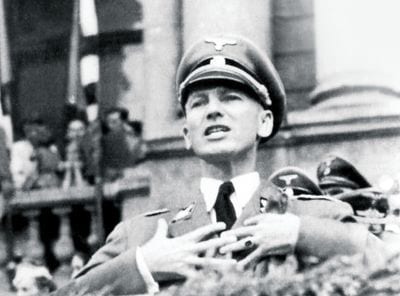
Wächter, as Governor of Galicia, showing off at a rally in front of the newly recruited SS Galicia Division.
Then came the Germans that had beaten Poland in a month. The Red Army replaced the Germans. In 1941, the same Germans and many Galicians—that were not of Jewish or Polish descent—already kicked it out of Lvov, deciding that the new “kind Kaiser” was Adolf Hitler. Banderite and Melnykite factions—from the broken Organization of Ukrainian Nationalists (OUN), a small, but extremely malevolent terrorist organization that lived before the war thanks to German intelligence—both raced to serve him.
But Hitler quickly dispelled Bandera’s illusions that he would conquer Kiev for him and give him power over all of Ukraine. He imprisoned foolish Bandera, and made Galicia into the fifth District (oblast) of the General Government—an occupation zone that was put together mainly from the former Poland. German was declared the official language, the head of the region was now the governor, whereas the raions were named in a true European fashion—“Kreishauptmannschaft.”
Hitler would hear nothing of independent Ukraine. He considered the Ukrainians, in general, and Galicians, specifically, to be Untermensch—subhuman. In the future, Galicia was subject to Aryanization, i.e., complete Germanization. In the meantime, Galicians were taken only into the police force and used in the dirtiest line of work, up to burning villages and executing prisoners of war, as was the case with the so-called Bukovinian Battalion (Bukovina Kuren—ed.) that burned down the entire Khatyn village with all its residents.
However, a crushing defeat at Stalingrad and Kursk at the hands of the Red Army, in which one in four soldiers was Ukrainian, forced the Führer to make certain amendments to his racial theory. Since those that the Nazis called “subhumans” with contempt ended up largely beating the true Aryans, then it was decided to use the other “subhumans” in the occupied territories to form individual units to fight the Red Army.
Thus, one by one, the Germans got 36 SS divisions formed mainly not out of native Germans, but out of those that were “sympathetic” to them—Wiking (out of Norway and Denmark natives), Charlemagne (out of the French), Wallonien (out of the Belgians), Nederland (this one is obvious), 15th (Latvian), 20th (Estonian), Handschar (Croatian), etc. Galizien was the 14th of these based on numeric chronology and the time of establishment.
The motivation for its creation came from below. Lvov professor of geography Vladimir Kubiiovich (or Wolodomyr Kubiyowich—ed.), member of OUN (M), was particularly interested in this idea. He approached Dr. Wächter, the Governor of Galicia and an Austrian by descent, who was well acquainted with local specifics. As Kubiiovich later recalled in emigration, “capable and ambitious” Wächter, who had some influence on Reichsführer-SS Himmler, believed that “Galicia was a country that must renew the German (Austrian) influence that was happening since the second half of the 18th century.”
Rather quickly, he convinced Himmler to establish this unit. The latter agreed, but pointed out that it should consist only of Galician residents, since this region was part of the Austrian Reich in 1772-1918 and was thus more credible than the other parts of Ukraine. On April 28, 1943 Lvov newspapers officially publicized this decision.
However, as the Reichsführer-SS insisted, the Division was not to be Ukrainian, but rather Galician. The Germans still did not recognize the existence of any Ukraine and, in the future, were going to return to their plan of Aryanizing the East. The newly formed unit was officially called the 14th Waffen Grenadier Division of the SS (1st Galician). (The word “Waffen” meant “weapon” and was added to those units of the SS that were formed from foreigners, not true Aryans.) This was one of the traits of its inferiority. Even the trident that the Germans allowed Ukrainian Polizei to wear was prohibited as the emblem of SS Galicia Division. According to contemporary Lvov historian Andrei Bolianovskii, in the book Ukrainian Military Units in the Armed Forces of Germany (1939-1945) (Ukraiinski viiskovi formuvannia v zbroinykh silakh Nimechchiny), Himmler allowed
“regional distinction only in their national colors. This was the emblem that was supposed to symbolize the local identity of this area and, at the same time, its association with the West (the combination on a blue background of ZUNR [West Ukrainian People’s Republic, 1918-1919—ed.] coat of arms of a yellow Galician lion, with three golden crowns that appear on it, was given to Galicia by the Austrian Empress Maria Theresa). The latter was instituted for the Galician Division, and the soldiers were to be called ‘Galicians’.”
Why Lvov nationalists hoped for a change in Hitler’s political course with this turn of events—we should ask them. Perhaps, for the same reason that their spiritual heirs are currently naively hoping to join the European Union.
“Treasure of the German Nation”
One of the neo-Nazi parties that currently preaches the tradition of SS Galicia Division in Ukraine calls it the “treasure of the nation.” Which nation, I wonder. Like the Austrians during the Habsburg days, Germans did not place much value in the Galicians as war material. If in the Russian army, the natives of Ukraine became generals and field marshals, then in the Austrian one, they became junior officers, at best. An Austrian, Hungarian, or a Croatian native could have a brilliant military career in the Habsburg Empire, but not Galicians. Certain reasons for this did exist.
For instance, during the famous 1916 Brusilov offensive, Russian troops broke through the Austrian front specifically in those areas, where they faced units with a high percentage of Galicians. It was they that ran off first. Hitler’s military men noted that experience.
Not only the commanders of Galicia Division were German, but also the entire headquarters and the vast majority of officers all the way to the company members. Brigadeführer Fritz Freitag led the Division. Major Wolf-Dietrich Heike ran the operations department. Intelligence was under Hauptsturmführer Fritz Niermann. Supply department—under Hauptsturmführer Herbert Schaaf. Sturmbannführer Erich Finder was the Commander’s aide. Friedrich Lenhardt and Herbert Hähnel were assignments officers. Karl Wildner, Hans Otto Forstreuter, Paul Herms, Karl Bristot, and Friedrich Beyersdorff commanded the regiments. Even the pharmacist was German—Hauptsturmführer Werner Benecke (not to be confused with any Beniuk [a Ukrainian name—ed.] by any means!). According to Andrei Bolianovskii, the Division “got a German command spine.”
Then what was left for the Galicians—those that wore their golden lion granted by Maria Theresa, giving it more attention than it deserved? The honorable mission of serving as cannon fodder for the Third Reich! Pedantic Germans took special care of this product. According to various sources, there were between 70 and 80 thousand volunteers that ran to sign up for this SS Division. They rushed to do so the same way they do toward ‘guest work’ in Europe today!
But the vast majority of them was turned away. Only 14 thousand were accepted into the Galicia Division. The rest did not pass the medical examination, largely because of height that had to be no less than 165 cm (5 feet 4 inches—ed.). Vain Himmler could not allow shorties to serve in the SS troops. The man of the SS must have a frightening appearance! Thus, the tallest human material was picked for Galicia, so there is no need to be surprised that nowadays this area doesn’t produce basketball players.
Adventures of Švejk of the SS
Let us not overestimate these volunteers’ enthusiasm. On the website for SS Galicia, you can find a humorous book that was published by one of its former soldiers, Yurii Tis-Krokhmaliuk, during emigration to Argentina, where he fled after his “feats.” It is called The Diary of a National Hero Selepko Lavochka (Shchodennik natsionalnogo geroia Selepka Lavochki). A certain emulation of The Good Soldier Švejk:
“July 2, 1943. Rode the tram carrying saccharin. German Schutzmannswere rounding people up. They caught me, too. They found my goods and confiscated them, of course, whereas I was taken to Gorodetske. There, they took my documents and put me behind the wired camp fence. I had to go work in Germany. They asked: What kind of work do you know? I said: all kinds. I can be an engineer, director, magister. They appointed me to look after pigs in a certain Prussian village.
July 3, 1943. Slept well and calmly all through the night. In the morning I stated that I’d like to volunteer for the Ukrainian Division. They released me immediately.”
In this text, if anything is untrue, then it is the name of the Division. In 1954, when it was published, it was uncomfortable to admit that you served in an SS division even in Buenos Aires. Thus, the author timidly renamed it to “Ukrainian.”
Even the order on establishing the Division clearly states: “Command language—Galician; order language—German.”
Crushing Defeat at Brody
[dropcap]R[/dropcap]ecruits underwent a standard training course, and, in the summer of 1944, they ended up near the town of Brody outside of Lvov. In an eloquent coincidence, they resisted the troops of the First Ukrainian Front. On July 13, the latter made a brilliant breakthrough, and SS Galicia immediately found itself surrounded. A week later, the Galicia Division took off running, trying to escape in small groups. Two thousand soldiers ended up as Soviet POWs. The rest were either killed or fled.
According to military historians, this Division had virtually ceased to exist by July 22. Only three thousand people escaped from being surrounded. Incidentally, one of the first members to flee was the Commander of this Division, Brigadeführer Freitag.
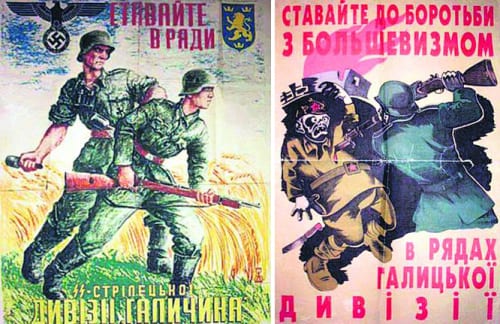
Recruiting posters from 1943. Even they make it obvious that this Division was called Galician, not Ukrainian.
The Germans filled Galicia with new soldiers from among those volunteers that they initially rejected, no longer embarrassed of their height, but ones who were almost never used in open battles against the regular units of the Red Army. The main task for these “divisioners” was fighting Slovak and Yugoslav guerrillas. Once Galicians even had a skirmish with Ukrainian partisans under Kovpak, who carried out a sabotage raid into Slovakia.
German command valued the military qualities of SS Galicia very little. For example, only one of its members was awarded the Iron Cross—Commander Freitag himself—whereas these awards were not uncommon in other Waffen-SS divisions.
Saved Their Own Skin…Pretending to be Poles
The following question arises: why was the majority of those survivors, who fought for SS Galicia, able to avoid being handed over to the USSR, as per agreement between Stalin and the Western Allies? The “Polish card” saved them! Since Galicia was part of Poland before 1939, and only former Soviet citizens were subject to being extradited, Western lawyers decided that their Polish citizenship had precedence over the short-lived Soviet period of 1939-1941. This is what the author of The SS: Hitler’s Instrument of Terror, Gordon Williamson, wrote on this subject:
“The bulk of this division was able to withdraw westwards in the closing days of the war and surrender to Anglo-American forces. Allied confusion over the status of personnel labelled as Galicians led to many being able to avoid forced repatriation to the Soviet Union. Despite their having served in the Waffen-SS, Polish General Anders took the pragmatic view that their past could be forgiven in consideration of their potential future usefulness as dedicated anti-Communists, and he supported their claim to be Polish…”
They were the “cream of the crop” of this nation all along, apparently! And where did real Ukrainians serve at that time? In the Red Army—the four Ukrainian fronts! That same one, in which General Rybalko commanded the tank army, Malinovskii, Cherniakhovskii, and Kirponos—the fronts, where Marshal Timoshenko was a Commissar (i.e., Minister) of Defense, and Kozhedub was the most famous flying ace in the anti-Hitler coalition. Can some pathetic, demolished SS Galicia Division outweigh ALL THIS?

Ivan Kozhedub, a Soviet military aviator, a three-time Hero of the Soviet Union, and one of the best-known aces of WWII.
P.S. The brain behind the establishment of SS Galicia, professor Kubiiovich, did not participate in any battles and died as an emigre in Paris in 1985 at the age of 85. Most of those who believed him died in their twenties.
[printfriendly]
What is $5 a month to support one of the greatest publications on the Left?

